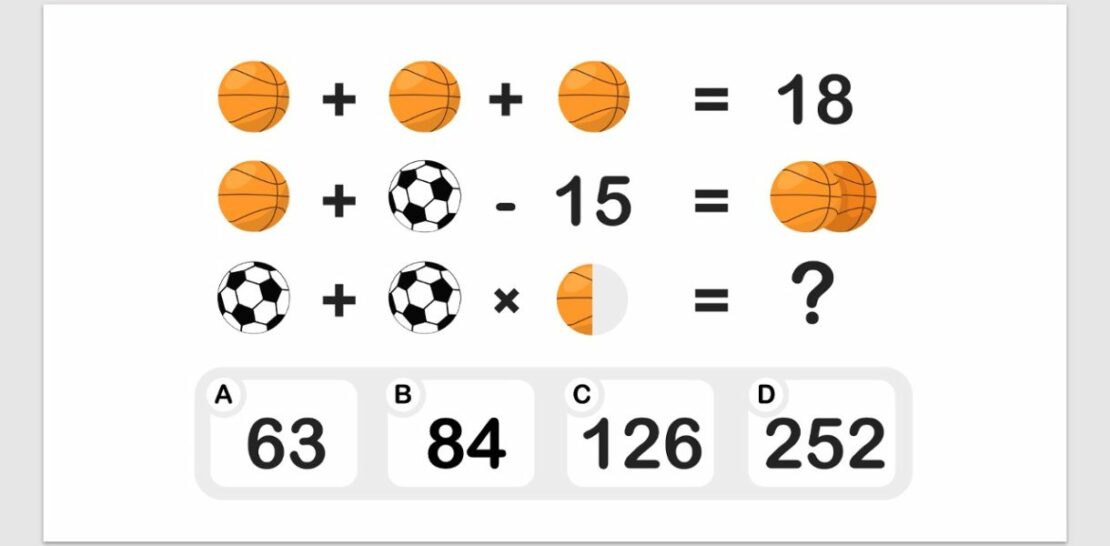Welcome, fellow language enthusiasts and aspiring geniuses!
Today, we embark on an intellectual adventure into the realm of mathematical logic, where numbers and symbols combine to create puzzles that push the limits of our cognitive abilities.
In this exhaustive exploration of IQ tests and their focus on mathematical logic, we will delve deep into the intricacies of these fascinating instruments, dissecting their components and uncovering the secrets to solving them quickly and efficiently.
So, without further ado, let’s begin our journey into the captivating world of IQ tests and see if you have what it takes to solve the equation in under a minute!
A Brief History of IQ Tests and Mathematical Logic
Before we dive headfirst into the challenge at hand, let us first take a moment to appreciate the origins of IQ tests and the development of mathematical logic as a key component of these assessments.
IQ tests, or intelligence quotient tests, have been employed for over a century as a means to measure and quantify human intelligence. The term “intelligence quotient” was first coined in 1912 by the German psychologist William Stern, who used the term to describe a person’s mental age divided by their chronological age. The first widely recognized intelligence test, known as the Binet-Simon scale, was developed in 1905 by French psychologists Alfred Binet and Theodore Simon as an instrument to identify children with cognitive delays. Since then, numerous iterations of IQ tests have been developed, each with its unique focus and methodologies.
Throughout the evolution of IQ tests, mathematical logic has played a central role in assessing an individual’s cognitive abilities. As a subfield of mathematics that investigates the principles of reasoning and inference, mathematical logic encompasses various symbolic systems that are used to represent relationships between objects and to deduce new information from known facts. The inclusion of mathematical logic problems in IQ tests allows for the evaluation of critical thinking and problem-solving skills, which are crucial components of general intelligence.
Dissecting the Equation: Understanding the Components of Mathematical Logic Problems
Now that we have established the significance of mathematical logic in the context of IQ tests, it is time for us to examine the various components that constitute these intriguing puzzles.
- Symbolic representation: One of the defining features of mathematical logic is its reliance on symbolic systems to represent relationships between objects. These symbols, which can include numerals, letters, and other abstract characters, are used to create equations and expressions that are designed to test an individual’s ability to decipher and manipulate these relationships.
- Logical operators: Central to any mathematical logic problem are the logical operators that dictate the interactions between the symbols in the equation. These operators, such as addition, subtraction, multiplication, and division, require the test-taker to understand the underlying mathematical rules and apply them correctly in order to solve the problem.
- Variables and unknowns: A key aspect of mathematical logic problems is the presence of variables or unknowns. These elements, often represented by letters, are placeholders for certain values that the test-taker must determine in order to solve the equation. Variables can add a layer of complexity to the problem, as they necessitate the application of critical thinking and problem-solving skills to identify the relationships between the different components of the equation.
- Constraints and conditions: In many cases, mathematical logic problems will include additional constraints or conditions that must be satisfied for the solution to be considered correct. These constraints can take various forms, such as limiting the range of possible values for a variable or requiring that the solution be a whole number. Understanding and adhering to these constraints is crucial for successfully solving the problem.
Strategies for Success: Tackling Mathematical Logic Problems Quickly and Efficiently
Having dissected the various components of mathematical logic problems, it is now time to explore the strategies and techniques that can be employed to solve these puzzles in a swift and efficient manner.
- Identify patterns and relationships: The first step in tackling a mathematical logic problem is to identify the patterns and relationships between the various symbols and operators in the equation. By carefully analyzing these relationships, you can begin to deduce the rules and operations that must be applied in order to solve the problem.
- Break down the problem into manageable parts: One of the most effective strategies for solving complex mathematical logic problems is to break them down into smaller, more manageableparts. By dividing the problem into simpler sub-problems, you can isolate the individual components that need to be addressed, making it easier to apply the appropriate rules and operations to each part. This process not only helps to simplify the problem but also allows you to focus on each aspect of the equation without being overwhelmed by the entirety of the challenge.
- Use substitution and elimination techniques: When dealing with variables and unknowns in a mathematical logic problem, substitution and elimination techniques can be invaluable tools for finding the correct solution. Substitution involves replacing a variable with a known value or expression, while elimination involves manipulating the equation to cancel out one or more of the variables. By employing these techniques, you can systematically narrow down the possibilities and zero in on the correct solution.
- Check your work and consider alternative solutions: It is always wise to double-check your work and consider alternative solutions when solving mathematical logic problems. By verifying your calculations and ensuring that you have adhered to the constraints and conditions of the problem, you can increase your confidence in the accuracy of your solution. Additionally, considering alternative solutions can help you identify any potential errors or oversights in your initial approach, allowing you to refine your strategy and arrive at the correct answer.
The Ultimate Challenge: Solving the IQ Test Equation in Under a Minute
Now that we have explored the history of IQ tests, dissected the components of mathematical logic problems, and examined the strategies for solving them, it is time to put our newfound knowledge to the test. Can you rise to the challenge and solve the equation in under a minute?
Consider the following equation:
3x – 5y = 20
Given that the values of x and y must be whole numbers between 1 and 10, can you determine the correct combination of values that satisfies the equation and its constraints? Remember to apply the strategies and techniques we have discussed, such as identifying patterns, breaking down the problem into manageable parts, using substitution and elimination techniques, and double-checking your work.
As you tackle this challenge, keep in mind the ultimate goal of solving the equation in under a minute. With practice and a thorough understanding of mathematical logic, it is entirely possible to achieve this impressive feat and join the ranks of those who excel in the realm of IQ tests and cognitive assessments.
In conclusion, the world of IQ tests and mathematical logic is a complex and fascinating domain that offers endless opportunities for intellectual growth and discovery. By delving into the history of these assessments, understanding the components of mathematical logic problems, and honing your problem-solving skills through the application of effective strategies, you can unlock the secrets of these enigmatic puzzles and challenge your mind in new and exciting ways. So, embrace the challenge, put your skills to the test, and see if you have what it takes to solve the equation in under a minute!




